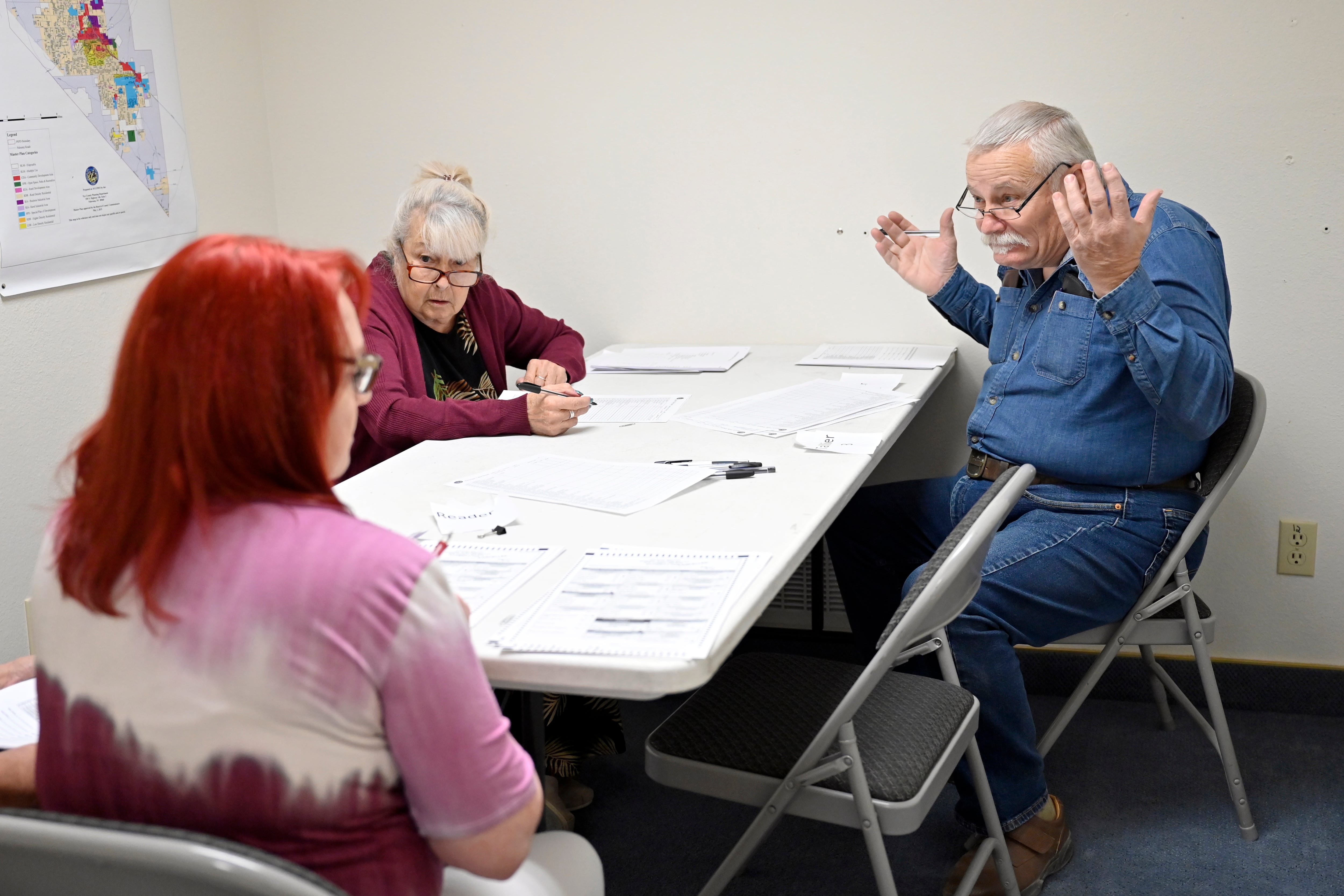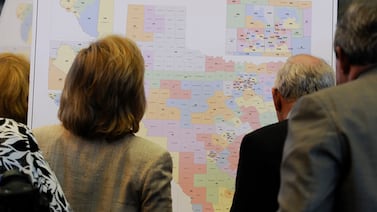Votebeat is a nonprofit news organization reporting on voting access and election administration across the U.S.
Despite widespread coverage of the follies of hand-counting ballots, the quest to expand use of the method continues. This year alone, there have been 16 bills in 8 states that would ban the use of tabulators. It’s a really bad idea. And so, Votebeat has decided to compile a list of our favorite cold-hard evidence.
I’m sure many of you already understand the broad strokes of this: years of evidence and basic common sense shows that hand-counting is less accurate, more time consuming, and significantly more expensive than using tabulators. Still, the same arguments continue to motivate local officials and activists to attempt to upend elections systems. Let’s go through them here, point by point.
Hand-counting is not a simple, straightforward task like advocates claim.
As you might have noticed from any of our coverage, election work is tedious. And it should be — election administrators are tasked with the weighty responsibility of counting ballots accurately and keeping them safe. This is central to democracy, but it is also a massive and carefully orchestrated logistical challenge.
Because the checks and seals and numbering of batches of ballots goes unseen by the vast majority of voters, it’s easy to believe hand-counting is straightforward. You just count the ballots, right? Nope.
Federal and state laws exist related to the treatment and organization and storage of ballots. Hand-counting processes, therefore, have to ensure that each ballot is properly stored in its correct location. Multiple people would have to work together if a voter’s selection was unclear to determine their intent, and write-in candidates are tabulated. Then, all of the ballots are returned to their appropriate batch.
Imagine inviting an entire city to a party, and then as you get the RSVPs you must keep them — by law — in order. And as you tally the RSVPs, you have to individually hand-tally 60 different food choices you’ve asked your guests to make. You have to do this repeatedly, 1,200 different times. Dozens of others you’ve recruited for the task have the same work ahead of them. How accurate do you think your guest list would be? Would the responses be organized when you finished?
If you play that out in your head, you’ll realize a few things: To accomplish this you’d need a lot of people, a lot of time, and a lot of space. All of those people would also have to understand all of the tricky little details that are required to keep this process accurate. All of this costs money.
That’s a lot of work, and a lot of steps that are easy to mess up.
For example, the Audit Guys — a group of election experts who reviewed Cyber Ninjas’ work and findings — wrote this of the hundreds of volunteers Cyber Ninjas recruited to hand-count all of Maricopa County’s ballots from the presidential election in 2020: “Sometimes they counted ballots by 50, sometimes by 100, sometimes they marked how many ballots were seen, other times they didn’t, sometimes they included subtotals, sometimes they didn’t, sometimes the errors were detected and corrected, sometimes they weren’t.”
Chaos.
Just because other countries hand-count ballots doesn’t mean it is feasible in the United States.
A popular argument from hand-counters is that if France hand counts its entire election in a single evening, why can’t we? Well, because of a lot of really simple-to-understand reasons.
France — which is one-fifth the population of the U.S. — has simpler ballots because they count one race. The United States counts pages of races at once, mashing together local, state, and federal choices onto one ballot. As a result of our diffuse federal system, our ballots are the longest of any democracy.
Still, hand-counting is less efficient in the United States even when the act is limited to a single race. For example, the recount ordered by Georgia Secretary of State Brad Raffensperger in 2020 was for the presidential election only, arguably similar to the hand counts done in France. This statewide effort amounted to the largest hand recount in U.S. history. It cost counties hundreds of thousands of dollars and took multiple days.
Do the math for yourself: If it took that long and cost that much to count one race, how much do you think it would cost to count more than 60 races by hand? That’s how many choices the residents of Fulton County, home of Atlanta, had to make in 2020.
In Cobb County — a suburban county north of Atlanta — the effort took five days and hundreds of volunteers. The administrator there estimated it would take 100 days to have counted the entire ballot in that same way.
There are some really good academic studies on errors made in hand counting.
The studies conclude these efforts are far more error-prone than counts using tabulators.
First, two political scientists — Stephen Ansolabehere and Andrew Reeves — compared the differences between the original count and the recount of several jurisdictions in New Hampshire. Some hand-counted ballots, and others used scanners. Ansolabehere and Reeves found that the difference between the recount and the original count was twice as large when hand-counted compared to when the ballots were tabulated by a scanner.
Then, in Wisconsin, Profs. Ansolabehere, Charles Stewart, Barry Burden, and Kenneth Mayer did a similar comparison using original counts and two statewide races — one state Supreme Court race in 2011, and the 2016 presidential election. In 2011, hand-counted ballots were off about twice as much as scanned ballots. In 2016, error rates for hand-counted ballots were one-third higher than scanned ones, though in all cases, they were small.
By 2016, though, error rates for both hand-counting and scanned ballots had gone down dramatically from the previous study in 2011. Stewart writes the improvement across the board was most likely the result of drastically better practices in the wake of the 2000 election, but notes, “both hand counting and scanners can be very accurate, but scanners are better.”
Regardless of the underlying technology that allows hand counting to be organized and finalized, “when rare, large discrepancies do arise, they occur because of poll workers’ decisions, such as stopping counting because they were tired or not counting write-in ballots considered irrelevant,” writes Stewart.
Scanners don’t get tired, and they can’t decide a write-in is irrelevant.
Another study from Rice University examined how human beings did when given 120 ballots to hand-count. Here, instead of one race, humans were asked to count the results of two races. Humans got the results wrong more than 30% of the time.
Ultimately, you don’t have to rely on theories or even studies to see with your own eyes how bad of an idea this is.
In Nye County, Nev., for example, a local commissioner attempted to reject the machine-counted ballots of his county’s 20,000 voters before ultimately agreeing to do a “parallel” hand count. It was performed by 170 volunteers working irregular hours and — because of difficulty in recruitment — did not follow bipartisan volunteer pairings as required by law. After the first day, the clerk who’d advocated for the whole thing estimated volunteers miscounted one-fourth of ballots.
Or, Arizona! After being hired by the Arizona Senate, Cyber Ninjas tried multiple times over three months in 2021 to count the 2.1 million ballots cast in Maricopa County’s 2020 election — using rotating tables to spin ballots, paper-counting machines, and spreadsheets. But texts from CEO Doug Logan released this summer show that they ultimately couldn’t make sense of their own numbers, and Logan admitted the numbers were “screwy.”
Cyber Ninjas’ final report confirmed Biden’s win and claimed that their hand-counting results were only hundreds off from the county’s results. But The Audit Guys analyzed the Cyber Ninjas data, comparing it with the county’s official record of votes cast, and found that the Ninjas failed to accurately count both ballots and votes cast. In one example, in which they analyzed the count of about 4,000 ballots, they found that counters awarded 12.4% more votes to Donald Trump than were included in the official results.
Please stop making elections worse by pretending hand counting is a good idea.
Not only is it inefficient, costly, and time consuming, it ensures that the ballots that need the most attention are given short shrift: The more time it takes to count ballots, the less time you have to resolve smudged marks, difficult-to-read write-in candidates, process provisional ballots and so on. These are simply a reality in elections.
As the studies and real world examples above show, it is in our best interest to let tabulators be tabulators and humans be humans.
Let computers do the repetitive work on standard ballots, and humans do the work to adjudicate unclear ballots and write-in candidates, so that every ballot truly does get counted accurately and with the best resources available.
Jessica Huseman is Votebeat’s editorial director and is based in Dallas. Contact Jessica at jhuseman@votebeat.org.






